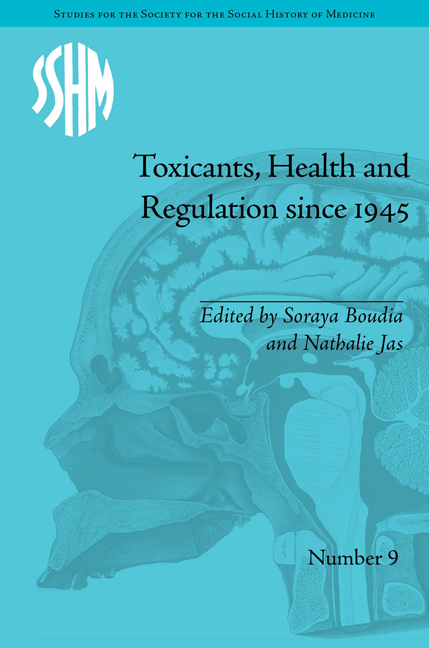Book contents
- Frontmatter
- Contents
- Acknowledgements
- List of Figures and Tables
- List of Contributors
- Introduction
- 1 The Cold War Over the Worker's Body: Cross-National Clashes Over Maximum Allowable Concentrations in the Post-World War II Era
- 2 Adapting To ‘Reality’: The Emergence of an International Expertise On Food Additives and Contaminants in the 1950s and Early 1960s
- 3 From Threshold to Risk: Exposure to Low Doses of Radiation and its Effects On Toxicants Regulation
- 4 ‘License To Expose’? Occupational Exposure Limits, Scientific Expertise and State in Contemporary France
- 5 Chemical Infrastructures of the St Clair River
- 6 Managing an Everlastingly Polluted World: Food Policies And Community Health Actions in the French West Indies
- 7 Chernobyl Empowerment? Exporting ‘Participatory Governance’ to Contaminated Territories
- Notes
- Index
1 - The Cold War Over the Worker's Body: Cross-National Clashes Over Maximum Allowable Concentrations in the Post-World War II Era
- Frontmatter
- Contents
- Acknowledgements
- List of Figures and Tables
- List of Contributors
- Introduction
- 1 The Cold War Over the Worker's Body: Cross-National Clashes Over Maximum Allowable Concentrations in the Post-World War II Era
- 2 Adapting To ‘Reality’: The Emergence of an International Expertise On Food Additives and Contaminants in the 1950s and Early 1960s
- 3 From Threshold to Risk: Exposure to Low Doses of Radiation and its Effects On Toxicants Regulation
- 4 ‘License To Expose’? Occupational Exposure Limits, Scientific Expertise and State in Contemporary France
- 5 Chemical Infrastructures of the St Clair River
- 6 Managing an Everlastingly Polluted World: Food Policies And Community Health Actions in the French West Indies
- 7 Chernobyl Empowerment? Exporting ‘Participatory Governance’ to Contaminated Territories
- Notes
- Index
Summary
Introduction
In the spring of 1959, representatives of twenty-six nations from both sides of the Iron Curtain gathered in Prague to negotiate. The Cold War was at its height: ten years before, NATO had been born, and in response, just four years prior, the Warsaw Pact. But this gathering in Prague featured neither diplomats, nor any mention of armaments or border disputes. Those who gathered in the Narodni Klub were mostly scientists, doctors and health officials. They sought, instead, to settle a striking divergence that had become ever more apparent over these same years in national approaches to industrial hazards. Specifically, they sat down to debate differences in so-called ‘Maximum Allowable Concentration Levels’ (MACs), the numerical limits many of these nations had established for toxins in their workplaces. Behind their disagreements, ostensibly over just what levels to prescribe, lay issues of appropriate knowledge and technique; also – as will come as no surprise to readers of this book a differences of culture and power. In broad outline, the contrasts were vintage Cold War: those from the US and the USSR sharply disagreed, and the Europeans were caught in-between. In ways that STS scholars or historians have as yet hardly explored, the disagreements also foreshadowed the future course of toxics regulation not just in workplaces but across many other spheres of the industrialized world.
- Type
- Chapter
- Information
- Toxicants, Health and Regulation since 1945 , pp. 25 - 46Publisher: Pickering & ChattoFirst published in: 2014

